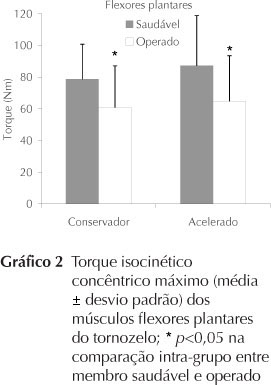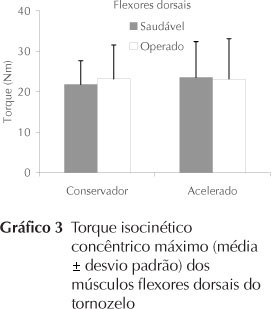Achilles tendon rupture reduces ankle plantarflexor (PF) muscles mechanical overload. This change in the ankle joint mechanics changes the natural muscle balance between dorsiflexor (DF) and PF muscles. The purpose of this study was to assess such imbalance by concentric conventional isokinetic torque ratios of patients who underwent different rehabilitation protocols after surgical repair of the Achilles tendon. After surgery, subjects were assigned to either a conservative or to an accelerated rehabilitation group. The conservative group (11 men, 41.3±7.9 years old) remained with a plaster cast for 6 weeks after surgery. The accelerated group (13 men, 43.5±13,7 years old) used a"robofoot" cast for 2 weeks and underwent ankle mobilization and early weight bearing for a period of 6 weeks post-immobilization. At 3 months post-surgery the ratio between the maximal concentric DF torque and the maximal concentric PF torque was evaluated with an isokinetic dynamometer. Torque ratios on the surgery side were higher (p<0.05) than on the sound side in both groups. No differences of muscle balance could be found between the groups. These results suggest that both groups require further rehabilitation to regain the natural muscle balance between surgery-side ankle DF and PF muscles.
Achilles tendon; Muscle, skeletal; Rupture; Torque



